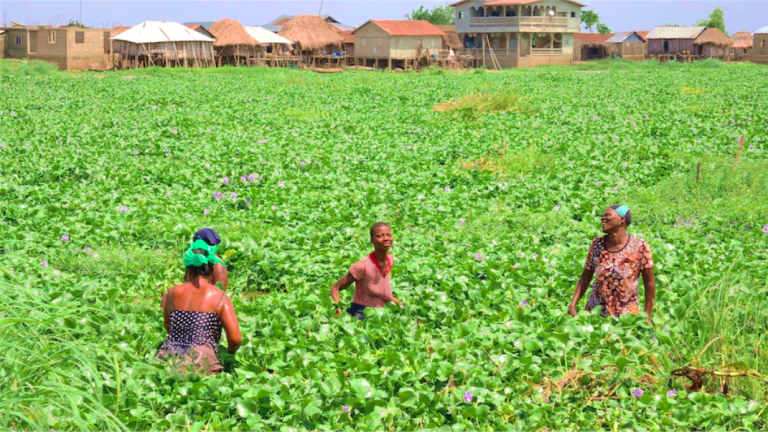
Green Keeper Africa, a Coastal Communities Solver, has developed an organic fiber made of water hyacinth, a highly invasive weed, that absorbs and cleans up oil-based pollutants.
In this Q&A, co-founder Fohla Mouftaou tells us more about Green Keeper Africa’s story.
What inspired you to start Green Keeper Africa?
Several years ago, David Gnonlonfoun, co-founder of Green Keeper Africa, was sailing on the Congo River as part of a consulting job when all of a sudden, his boat stopped moving. He was stuck in a thick layer of plants that stretched as far as the eye could see. He immediately recognized them as water hyacinth, a common weed in his home country of Benin.
Rather than seeing these invasive weeds as a barrier, Gnonlonfoun saw this gigantic mass of plants as an opportunity. By using these raw materials, he could help control the spread of an invasive weed while creating other sources of value. And thus, the idea for Green Keeper Africa was born.
What makes Green Keeper Africa’s model unique?
Green Keeper Africa has developed an innovative reuse process that creates economic, environmental, and social value. Our model can be replicated in all African countries.
We create a 100 percent plant-based fiber that absorbs up to 17 times its weight in pollutants! This fiber is sold to manufacturers, enabling them to react appropriately in the event of a hydrocarbon leak—reducing the consequences of industrial pollution. Furthermore, once the fiber is used, it can be recycled into alternative fuel for cement plants.
To harvest the water hyacinth, we’ve developed a community collection system that challenges the mechanized collection system used to date. These harvesting jobs create a new source of income for lake communities. And by using water hyacinth as our raw material, we’re also helping to control an invasive weed.
What's one challenge you've experienced, and how did you overcome it?
When we were first starting out, developing our network of water hyacinth collectors was a challenge. Many lake communities considered water hyacinth to be useless, and they were reluctant to invest their time and energy to harvest it.
To overcome this, we raised awareness about the devastating environmental and social effects of water hyacinth. Since these efforts began, our harvesting network has grown from a dozen to nearly 1,000 harvesters in five years, 85 percent of whom are women.
Local communities used to call water hyacinth “Togblé,” meaning “the country is screwed up.” Now, harvesters are calling it “Tognon,” meaning “the country is good!”
What advice do you have for new social entrepreneurs?
Social responsibility must be embedded in your core business strategy—not included as an “add-on.” When making decisions, always consider an action’s broader social impact.
During the first months, or years, a company might not have the resources to support strong social impact. This is not an issue, though, because social impact should grow in proportion to the company's activity. A company’s first objective is to be sustainable in all ways; when it creates financial sustainability, it should enhance its environmental and social sustainability as well.
This approach may reduce the beneficial margin today, but it will increase overall sustainability and financial returns in the long run: community adhesion, company culture and values, staff motivation, hiring conditions, and more.
What do you wish everyone knew about wetland communities?
Wetlands hold a wealth of resources for the planet: trapped carbon, incredible biodiversity, buffering abilities, and more. They are also a source of resilient economic opportunities for the future.
Due to factors such as population increase and unsustainable water management interventions, wetland communities will soon be forced to transition to new ways of life. There is an urgency in gathering data and knowledge on this ecosystem transition to enable these communities to design and prepare for their future.
What do you hope to gain from being a Solver?
Being a Solver will lead to new ideas and partnership, within coastal communities and beyond! Green Keeper Africa is one of 33 startups in the 2018 Solver Class.
Learn about all the innovative solutions here.
https://solve.mit.edu/articles/how-this-startup-used-a-flower-to-clean-…





